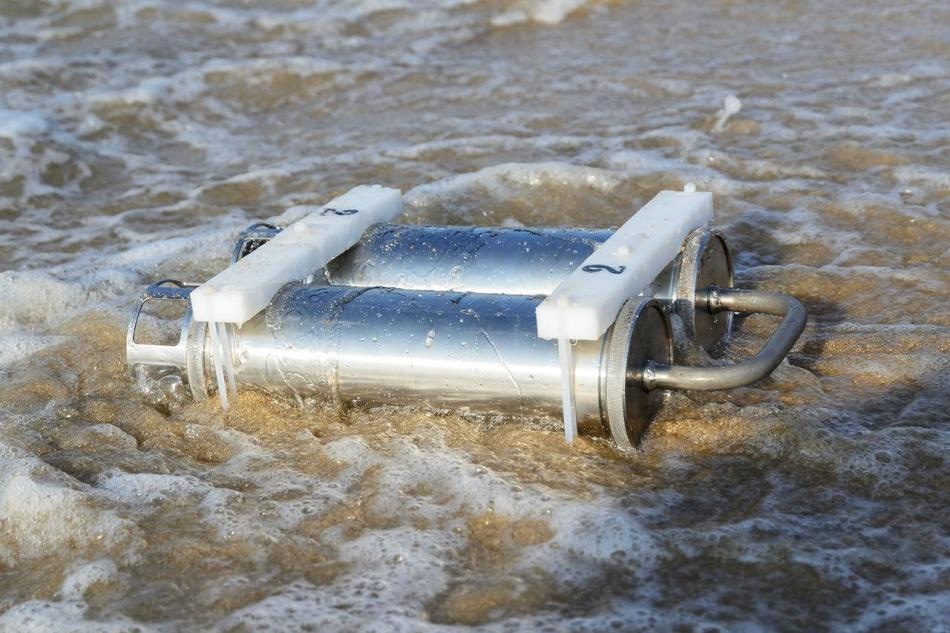Oct 6 2017
A seismic station for investigating the presence of hydrocarbons has been created and analyzed at the MIPT Center for Molecular Electronics (CME). The innovative device has an unprecedented bandwidth which allows it to uncover the structure of underground reservoirs even at depths of tens of kilometers.
The seismic station can be installed at depths of nearly 0.5 km in the Arctic and in the South Seas, and can be used for onshore, transition-zone, as well as marine investigation. The outcomes of the analysis have been reported in the Journal of Atmospheric and Oceanic Technology published by the American Meteorological Society.
 An autonomous seismic station developed at MIPT is unmatched in terms of several key parameters. (Credit: MIPT)
An autonomous seismic station developed at MIPT is unmatched in terms of several key parameters. (Credit: MIPT)
Globally, the standard method used for the investigation of hydrocarbon is active seismic surveying, which involves generating seismic waves at the surface of Earth or under water. These waves then pierce through water or soil and travel tens of kilometers downward. The seismic sensors collect the waves reflected back to the surface of Earth. Information related to the position and characteristics of underground structures is contained in the reflected signal.
The seismic station that we developed can be mounted on the seafloor or on land for the purpose of conducting oil and gas exploration. It is a sealed module packed with its own power source, a range of highly sensitive seismic sensors developed by our team, and a signal recording system. The data collected by the sensors are written into a built-in storage unit. The station is equipped with interfaces for setting up the recording parameters, as well as downloading data and transmitting them to the central station for subsequent processing.
Vadim Agafonov, Head of the Center for Molecular Electronics, MIPT
The station has the ability detect and collect seismic signals including data handy for investigating the presence of hydrocarbon. Normally, during shelf investigation, a network of stations located on the seafloor is used. Seismic waves are generated by blasting compressed air using powerful air guns installed on a ship.
The generated waves move toward the seafloor and penetrate the ground. When the waves travel further down, they are reflected from the surfaces they hit. A seismic station has the ability to detect the reflected signal for further investigation. Thus, underground structures, such as prospective hydrocarbon reservoirs, can be unearthed. The station has the ability to function onshore, on rough terrain, on ice and in transition zones in which the land meets sea. It is unaffected even under hostile situations, for example, temperatures ranging from -30 °C to 65 °C.
The data gathered by the land-deployed modules are relayed to the central station, in real time, for further processing. On the contrary, the data gathered at stations positioned on the seafloor can be transmitted to the central unit at the end of the experiment. The station is constructed such that it can self-govern itself and can continuously record data for a period of 30-60 days, based on the parameters being recorded.
The distinctive seismic sensors deployed in the device were designed at MIPT. Each sensor comprises a micron-sized node inserted in a liquid with higher electrical conductivity. The seismic signal makes the liquid to move in relation to an electrode, thereby having an impact on the current between electrodes. The sensors enable the recorded signals to be digitized and stored inside the internal drive.
The operation ability of the system is far better than that of prevalent analogs. Most of the similar seismic stations that are used at present include electromechanical geophones that have bandwidths of 10-250 Hz. The bandwidth of the sensors designed at CME is 1 Hz, thus allowing low-frequency waves (with the ability to travel the farthest) to be gathered.
In general, it is highly difficult to install marine and transition-zone investigation systems onshore owing to their size and weight. Furthermore, land-based stations cannot be used offshore as they are not waterproof. The seismic sensor designed at MIPT is ubiquitous. It even includes most advanced hardware components and circuitry.
The field investigations were performed on the shore of the Sea of Azov in Krasnodar Krai, a territory in southwestern Russia. A network including 17 stations was deployed on the seafloor, and a control station was installed on the shore. The stations allowed synchronized gathering of hydroacoustic and seismic signals at preset recording sites.
Apart from standard data collection, the system was adequately sensitive to pick up the August 7th earthquake that occurred in Ukraine, even though it was installed 200 km from the epicenter of the quake. Thus, the seismic stations have been demonstrated to be useful for seismic and seismological research on the seafloor as well as in transition zones, involving detection of low-frequency occurrences (e.g. regional earthquakes).
The device has already been admired by Rosneft, Lukoil, and other companies.
The Ministry of Education and Science of Russia supported this study.